Engagement Rings of the 1940s: A Cultural Reflection
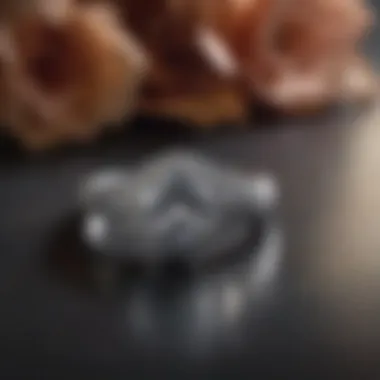
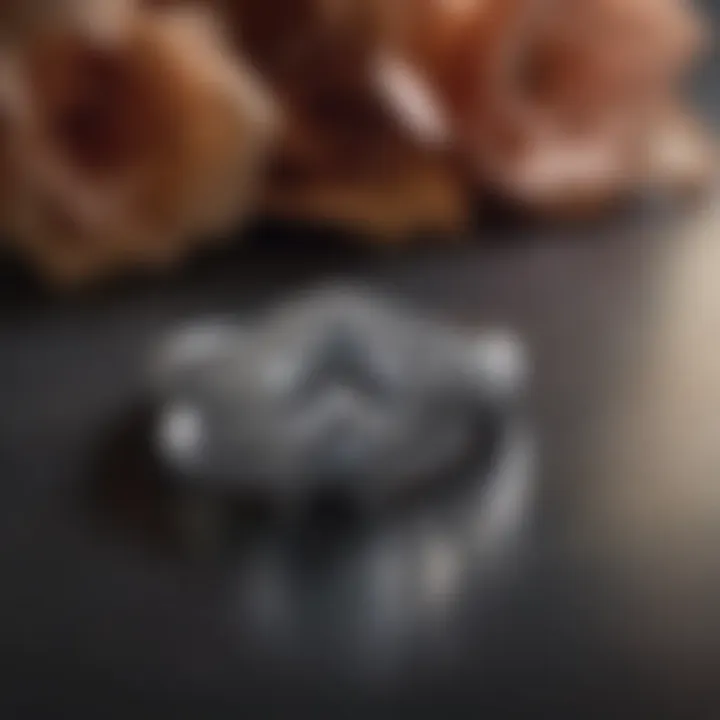
Intro
The world in the 1940s was like no other. A time swathed in the complexities of war and the subsequent transition into peace, this decade marked dramatic shifts not only in politics but also in personal lives. Amid the chaos of World War II, the engagement ring served as a symbol of hope and love. It was during these years that couples began to express their commitment in new ways, with the rings they chose reflecting not just their personal tastes but also larger societal changes.
Throughout this article, readers will embark on a journey back in time to explore the significance of engagement rings from this iconic decade. Not just pieces of jewelry, these rings encapsulated a wealth of emotion and evolving styles, making them worthy of examination. We’ll dive deep into the materials used, the prominent designs, and the cultural context that shaped these meaningful tokens of affection.
The exploration will highlight the craftsmanship that became essential during and after the war years, emphasizing how these creations mirrored contemporary societal norms and aspirations. Just as the world was changing, so were the expressions of love, making this a pivotal era for engagement rings, with lasting implications on jewelry design that resonate even to this day.
Gemstone Overview
Definition of Gemstones
Gemstones are more than just shiny objects that catch the light; they are enduring symbols of beauty and sophistication. At their core, gemstones are naturally occurring minerals, formed over millions of years, which have been cut and polished to create stunning embellishments. The allure of these stones ranges from their vibrant colors to the stories they’re capable of telling, making them invaluable in the art of jewelry making.
Classification of Gemstones
Gemstones can generally be divided into two broad categories: precious and semi-precious gemstones. Precious gemstones, such as diamonds, rubies, sapphires, and emeralds, are rare and often command high prices due to their demand and beauty. On the flip side, semi-precious gemstones include a wider variety, such as amethyst, aquamarine, and garnets. Despite being less rare, these stones are still cherished for their unique qualities and vibrant colors.
- Precious Gemstones:
- Semi-Precious Gemstones:
- Diamonds
- Rubies
- Sapphires
- Emeralds
- Amethyst
- Aquamarine
- Garnet
- Peridot
Historical Significance
Origins of Gemstone Use
The allure of gemstones can be traced back to ancient civilizations, many of which imbued these stones with spiritual significance and believed they held mystical powers. Various cultures recognized the value of gemstones, using them not just as adornments but as symbols of status. Ancient Egyptians, for example, prized lapis lazuli, associating it with royalty and the heavens. Meanwhile, Romans viewed pearls as tokens of wealth and virtue, suggesting that the use of gemstones was deeply embedded in the fabric of human history.
Cultural Insights: Gemstones in Ancient Civilizations
Across the globe, gemstones played a pivotal role in the lives of countless societies. In India, emeralds were worshipped as symbols of good fortune and were often seen in royal collections. The Greeks, influenced by mythology, selected stones based on their astrological beliefs, assigning different meanings and powers to various gems. These practices laid the groundwork for how gemstones would be viewed in the context of engagement rings during the 1940s, emphasizing emotion and connection.
"Gemstones have been symbols of power, beauty, and commitment for centuries, but their significance morphed dramatically in the wake of the 1940s."
Prelude to Engagement Rings
Engagement rings from the 1940s stand out as significant symbols of love, commitment, and societal transformation during a unique decade. Understanding their importance entails appreciating the interplay between craftsmanship, cultural shifts, and historical context. These rings not only reflect the personal aspirations of couples but also embody the broader economic and artistic trends that marked the period following World War II.
Defining the Era of the 1940s
The 1940s were a turbulent hive of activity and change. The backdrop of World War II imposed severe constraints on material availability, impacting manufacturers in countless ways. With the onset of the war, many jewellers were forced to adapt, often repurposing existing materials or simplifying designs to comply with restrictions on precious metals and stones. Therefore, defining this decade goes beyond mere aesthetics; it’s about resilience and innovation in the face of adversity. Engagement rings evolved in symbolism and style—a spoonful of hope amid uncertainty. Jewelers started incorporating designs that simplified forms yet added a touch of elegance suitable for the optimistic spirit of the post-war years.
Cultural Context of Engagement in the 1940s
Engagements during the 1940s took on heightened significance as young couples sought to solidify their commitments against the backdrop of a world embroiled in chaos. The pressures of war led many to realize the fragility of life, making the promise of love even more crucial. This fervor for commitment often resulted in quicker engagements and marriages. Couples, influenced by wartime values, frequently looked for rings that were compact yet rich in meaning.
Socially, these engagement rings mirrored the affluence and aspirations of the newly emerging middle class post-war. The designs began to reflect a combination of modesty and flair, striking a juxtaposition between personal yearning and the practical nature that characterized the era. As the economy gradually rebounded following WWII, consumer confidence swelled, allowing couples to invest in more expressive and intricate pieces. Engagement rings thus became not just personal tokens but also markers of social status, symbolizing both love and a hopeful return to normalcy.
Materials and Craftsmanship
Engagement rings from the 1940s offer a window into the artistic and societal values of their time. The choice of materials and the craftsmanship that went into these rings reflect not only the tastes of individuals but also the broader economic conditions and cultural nuances of the era. Understanding these components is crucial for appreciating the significance of 1940 engagement rings. Jewelry in this time was often shaped by the hardships and triumphs of World War II, leading to a blend of durability and beauty. The craftsmanship involved in creating these rings was meticulous, emphasizing handcrafted artistry over mass production, an aspect that adds a personal touch to each piece. Additionally, the types of materials selected played into the symbolism attributed to love and commitment.
Popular Gemstones Used in the 1940s
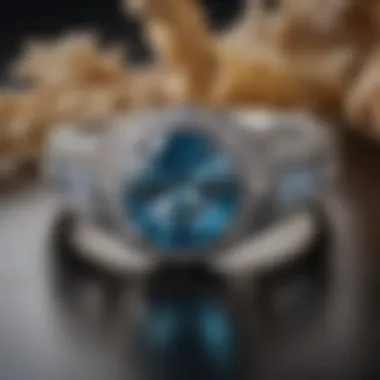

Diamonds
Diamonds were the crown jewel of engagement rings in the 1940s, and their presence had much to do with their lasting allure. Beyond their spectacular sparkle, diamonds symbolize eternity, making them a fitting choice for a lifelong commitment. The major characteristic of diamonds is their hardness; being the hardest natural material known, they are resistant to scratches, hence remaining beautiful through the years. This durability made them a popular selection during a time when couples, influenced by economic uncertainty, sought longevity in their investments.
"A diamond is forever," is more than a slogan; it embodies the essence of the promises made with such a ring.
However, it’s essential to note that diamonds come with their share of disadvantages. The rise in diamond prices during the post-war era made them less accessible, prompting some couples to explore alternative options while still wanting something that held the same significance.
Sapphires
Sapphires offered an alternative that blended uniqueness with elegance. Known for their deep blue hue, sapphires symbolize sincerity and fidelity, making them a romantic choice for couples navigating the changes after the war. One key characteristic of sapphires is their versatility; besides the iconic blue, they come in a variety of colors, which allows for customization in engagement rings.
The unique feature of sapphires lies in their brilliance and luster, which can rival diamonds. But, unlike diamonds, they often come with a relatively lower price tag, making them a more accessible option for many. Yet, their hardness, while impressive, is slightly less than that of diamonds, which may be a consideration for couples thinking about everyday wear.
Emeralds
Emeralds, with their vivid greens, brought a touch of nature’s luxury. This gemstone is linked to rebirth and love, aligning perfectly with the ideals of new beginnings that many couples were seeking after the chaos of wartime. The richness of color in emeralds is stunning and can be an eye-catching centerpiece for an engagement ring.
What sets emeralds apart is their propensity for inclusion—often referred to as “jardin,” French for garden. This unique feature can add an individual touch to each emerald. However, their softness compared to diamonds means they are more prone to scratches, which raises concerns regarding their durability for everyday wear.
Metals and Settings in Engagement Rings
Gold Varieties
Gold has long been a staple for engagement rings, and during the 1940s, various gold varieties were prominent. Yellow gold was particularly popular, symbolizing warmth and connection. The malleability of gold allowed artisans to create intricate designs and settings that reflected the era's romantic ideals.
A key characteristic of gold is its resistance to rust and corrosion, ensuring longevity. However, over the decade, variations like white gold began to emerge, changing the landscape of jewelry design. While yellow gold was traditional, white gold offered a contemporary twist that appealed to younger couples looking for something different.
But, something to keep in mind is the maintenance these metals require; while gold is sturdy, over time it can lose its luster and needs periodic polishing to maintain its shine.
Platinum Significance
Platinum came into its own in the 1940s, being hailed as a metal of luxury and prestige. With its brilliant white color and weight, it exudes a sense of elegance and sophistication that was sought after in engagement jewelry. One defining characteristic of platinum is its durability; it is denser and more resistant to wear than gold, making it a valuable option for rings that endure daily life.
Platinum’s unique feature lies in its hypoallergenic properties, appealing to couples sensitive to other metals. However, its higher price point could be a drawback for some, steering budget-conscious buyers towards gold. Still, for those who opted for platinum, they were likely investing in a ring that would endure the test of time with minimal upkeep.
Popular Styles of Engagement Rings
When delving into the world of 1940 engagement rings, one cannot overstate the charm and relevance of the styles that emerged during this decade. The popular styles not only reflect the artistic expressions of the time but also encapsulate the emotional sentiments associated with commitment and love. The evolution of these rings tells a story of resilience, hope, and the longing for a brighter future following the turmoil of World War II. In examining these styles, one must consider the societal factors that influenced consumer preferences, the craftsmanship that adorned these pieces, and the enduring characteristics that maintain their allure.
Classic Solitaire Settings
Classic solitaire settings paved the way for engagement rings in the 1940s. Evolving from earlier designs, the solitaire style presents a single prominent gemstone, typically a diamond, held in place by a simple yet elegant band. This approach highlights the stone’s natural beauty, allowing the diamond to take center stage. The significance of the solitaire setting lies in its symbolism: a single stone representing an unbroken bond between two individuals.
These rings often exhibit clean lines and minimalistic designs that were favored during the war years, as gold and platinum were in high demand and precious resources were scarce. The solitaire style distinctly embodies simplicity and elegance, making it a timeless choice that transcends trends. Its unparalleled versatility allows it to be paired with various wedding bands, further enhancing its charm.
Intricate Vintage Designs
The intricate vintage designs from the 1940s showcase the craftsmanship of the period and evoke a sense of nostalgia. With their elaborate details and thoughtful artistry, these rings reflect individuality and creativity. From delicate floral motifs to ornate scrollwork, these pieces encapsulate romance and history, often becoming heirlooms passed down through generations.
Filigree Work
Filigree work is a hallmark of vintage design that defines many engagement rings from this era. This technique involves twisting fine threads of metal into intricate patterns, creating delicate and airy designs. One key characteristic of filigree is its light and lacy appearance, which contributes significantly to the overall elegance of a ring. The beauty of filigree lies in its ability to combine artistry with craftsmanship—each piece feels unique, personal, and often tells a story of its own.
Although filigree rings are admired for their delicacy, there are considerations for those who wear them. The intricate details may demand more careful handling to avoid damage. However, the unique feature of filigree is the ability to customize, allowing wearers to add personal touches that resonate with their love story, making it a popular choice for those who seek meaningful engagement rings.
Art Deco Influence
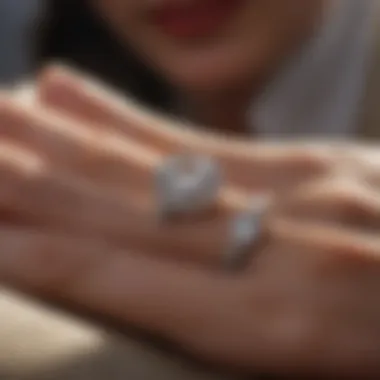
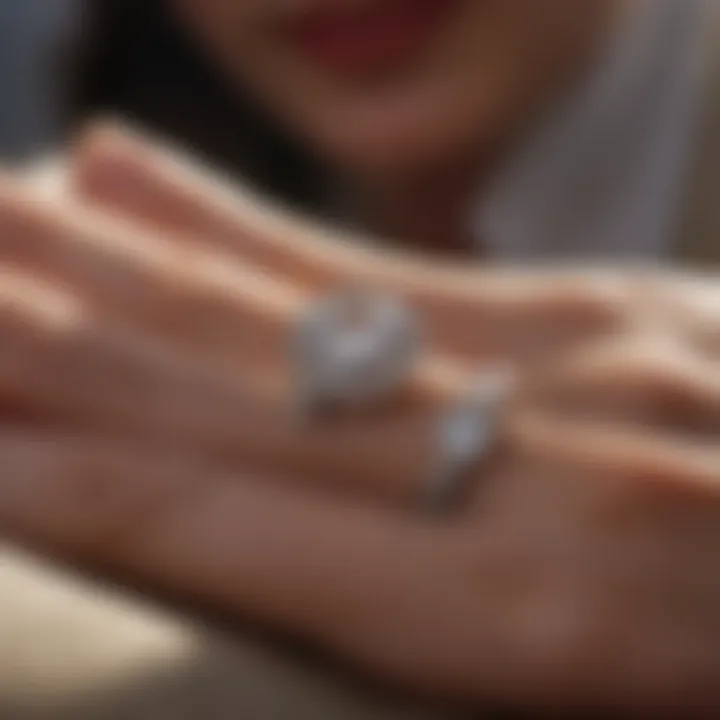
Art Deco, a style that flourished in the 1920s and continued to inspire designers into the 1940s, left an indelible mark on engagement ring aesthetics. Characterized by bold geometric shapes, vibrant colors, and lavish materials, this influence brought a sense of modernism to the traditional engagement ring. The key characteristic of Art Deco influence lies in its ability to merge elegance with opulence, creating statement pieces that capture attention.
One unique feature of Art Deco rings is their use of contrasting materials, like combining yellow gold with white metals to create striking visual contrasts. This design approach reflects the optimism and newfound freedom that emerged after the war. However, compared to more classic styles, Art Deco rings might be perceived as less versatile, as their bold designs might not pair seamlessly with every style of wedding band.
Ending
The popular styles of 1940 engagement rings reveal more than just aesthetic preferences; they represent a time of transformation in society, the resilience of love during hardship, and enduring beauty. Whether drawn to the simplicity of a classic solitaire or the intricate artistry of vintage designs, each piece remains a cherished embodiment of commitment—a testament to both historical significance and personal meaning.
Socio-Economic Factors Influencing Jewelry Design
Engagement rings from the 1940s are more than mere baubles; they encapsulate a pivotal time in history shaped by socio-economic factors. Understanding these influences provides deeper insight into the designs and materials that made this era distinct. World War II and its aftermath not only impacted the craftsmanship of jewelry but also shifted societal values, altering perceptions of love and commitment. The tension of wartime and the hope of post-war recovery created a unique backdrop for engagement rings that couples would choose during this era.
Impact of World War on Jewelry Production
World War II cast a long shadow over the entire globe, and the jewelry industry was no exception. As nations turned their resources toward the war effort, the production of non-essential items, including luxury goods like engagement rings, came to a near standstill. Precious metals such as gold and platinum were earmarked for military use, leading to a scarcity that fundamentally changed the materials available to jewelers.
During the height of the war, many jewelers had to get creative, often substituting materials or innovating new techniques to craft rings. For example, some designs began to feature lesser-known metals, such as palladium, while others incorporated synthetic stones alongside natural gems due to shortages. This shift not only altered the aesthetics of rings but also encased them with the resilience and adaptability that marked the period. Couples often sought engagement rings that reflected both their love and an enduring sense of hope—an emblem of normality in a chaotic world.
Post-War Economic Growth and Consumer Choices
As the war ended, a surge of economic growth unfolded, especially in the early years of the 1950s. Soldiers returned home, jobs became plentiful, and consumer spending bounced back. The newfound economic prosperity allowed couples to invest in more extravagant engagement rings, which were seen as symbols of stability and a bright future.
During this time, traditional values emphasizing commitment and the importance of marriage were amplified. Statistically, marriage rates spiked, and young couples were eager to embrace the American Dream, showcasing their love through grand gestures, including lavish rings. This surge in demand catalyzed innovative designs and a resurgence of platinum settings alongside diamonds—jewelry that was not just stylish but also reflected their changing economic status.
The shift from wartime restrictions to a consumerist boom fundamentally changed the designs, making them larger and more intricate than ever before.
Market trends indicated that people increasingly gravitated toward solitaire settings and intricate vintage designs, embedding deeper meanings and sentimental values into the rings. Therefore, engagement rings in the 1940s not only fulfilled their role as markers of commitment but also acted as reflections of economic stability and evolving societal expectations.
Significance of Engagement Rings in the 1940s
Engagement rings during the 1940s were much more than mere pieces of jewelry. They carried deep meanings of commitment and love, becoming a tangible representation of romantic promises. This decade, clouded by the shadow of World War II, transformed the sentimental values tied to these rings. Couples sought to solidify their bonds, often using engagements as a way to convey hope and stability during turbulent times. In this period, engagement rings symbolized not just personal connections but also a communal resilience amidst adversity.
Symbolism of Commitment and Love
In the context of the 1940s, engagement rings held significant weight as symbols of commitment. The recent effects of World War II included many societal changes that redefined relationships and partnerships. Couples were often compelled to make serious commitments in a world where uncertainty loomed large. Thus, the engagement ring became a staple in expressing love during this period.
"Engagement rings were more than adornments; they were anchors in the storm of life's uncertainties."
The simple yet elegant designs of the engagement rings encapsulated the essence of devotion. The use of platinum and gold enhanced this symbolism. Couples were looking for something that not only represented eternal love but also was durable enough to withstand the test of time. The subtle sparkle of a diamond or a gem set in a classic setting spoke volumes about one's feelings and intentions.
Here are a few reasons why the symbolism of commitment was particularly pronounced in the 1940s:
- Historical Context: Many couples experienced separation due to military enlistment, making the act of engaging even more significant.
- Cultural Traditions: Post-war, people leaned heavily into traditions, valuing rituals that affirmed love and commitment.
- Shared Experiences: The hardships faced during wartime brought couples closer, making the promise of engagement a sacred vow of support and understanding.
Engagement Rings as Status Symbols
In the 1940s, engagement rings began to evolve as not just symbols of love, but also markers of social status. The affluent often flaunted elaborate designs, while others opted for simpler yet meaningful pieces. This subtle shift underscored the societal trends of the time where wealth and prosperity were intertwined with personal expressions of commitment.
As economic recovery started to manifest post-war, distinctions in engagement rings became clearer. People began to associate the quality of materials and the intricacy of designs with affluence. Rings adorned with larger diamonds or intricate filigree were seen as marks of prestige, while simpler bands reflected modesty.
Some notable trends included:
- Diamond Centers: Larger stones were sought after, displaying one's capability to provide and commit.
- Art Deco Styles: These designs became a favorite for their unique flair, signifying an appreciation for beauty amid the hardships of the time.
- Personalized Touches: As individuality grew in importance, custom designs that told a couple's unique story became increasingly popular.
In summary, engagement rings of the 1940s encapsulated significant cultural, emotional, and social dynamics of the time. They transformed into emblems of commitment while also serving as outward markers of status, allowing couples to convey both personal sentiments and societal standings.
Comparison to Other Decades
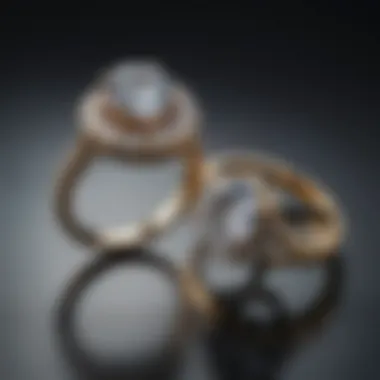
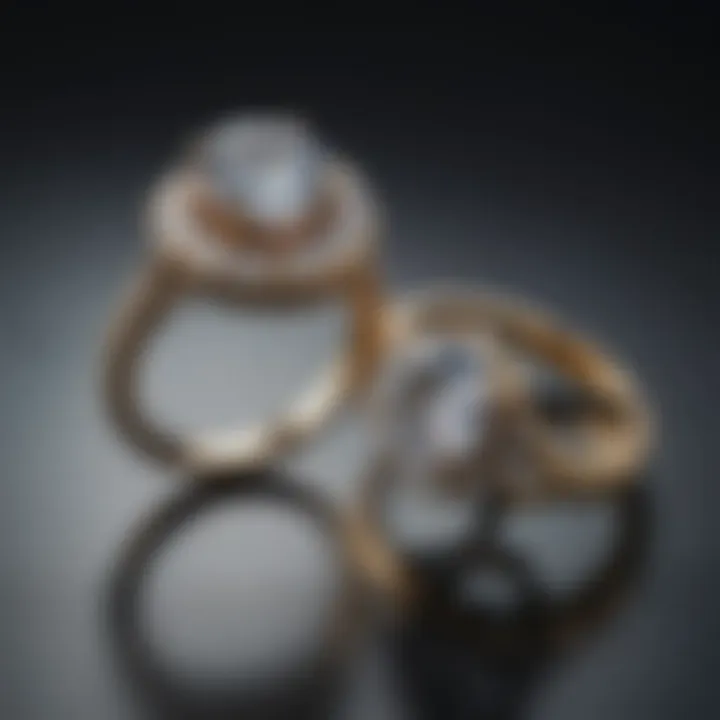
Exploring engagement rings from the 1940s in comparison to adjacent decades not only enhances our understanding of the jewelry itself but also reveals the socio-cultural shifts that shaped them. Each decade, like a chapter in a rich novel, has its own narrative, and the rings serve as artifacts that encapsulate those stories. In examining the transition from the 1930s to the 1950s, we can see not just the evolution of style, but also the reflection of shifting societal norms and economic conditions.
Engagement Rings from the 1930s
The 1930s were a time when the world was grappling with the consequences of the Great Depression, and this had a noticeable impact on engagement rings. Gold was still revered, but the focus was often on durability and value rather than extravagance. Diamonds continued to be the darling of engagement rings, but the designs leaned towards subtlety and modest elegance.
Features of 1930s Engagement Rings:
- Art Deco Designs: Rings often featured geometric patterns, with clean lines and symmetric shapes. This style emphasized craftsmanship over ostentation, reflecting the constraints of the time.
- Affordable Materials: While diamonds were prized, cheaper alternatives like moissanite or colored gems like garnet became more popular. Couples favored rings that offered beauty without breaking the bank.
"The pragmatic beauty of 1930s engagement rings reflects a time when love was cherished more than displays of wealth."
Thus, 1930s rings left a legacy that valued meaning over material. This sense of value would set the stage for the opulence and optimism that characterized the following decade.
Shifts in Styles in the 1950s
As the world emerged from the devastation of World War II in the late 1940s, the 1950s ushered in an era of prosperity and flamboyance. The stark contrasts between the rings of the 1940s and those of the 1950s exemplify this shift dramatically. This decade saw an explosion of designs that celebrated wealth and romance with abandon.
Highlights of 1950s Engagement Rings:
- Increased Gem Quality: Diamonds were larger and of higher quality, reflecting the economic recovery and a newfound emphasis on luxurious living.
- Romantic and Whimsical Designs: The rings featured elaborate settings, often with clusters of smaller stones surrounding a central gem, exhibiting a strong penchant for whimsicality. Styles such as the "three-stone" became fashionable, symbolizing the past, present, and future.
- Use of Tension Settings: The introduction of innovative techniques, like tension settings, began to take hold, showcasing gemstones seemingly floating between metal.
Collecting Engagement Rings Today
Collecting engagement rings from the 1940s has grown in popularity as people become more interested in pieces that not only exhibit beauty but also carry deep sentimental value and historical significance. For many, these rings represent a tangible link to a pivotal era in history, where love and commitment flourished despite the turmoil of World War II. The allure of a vintage piece isn’t just about its design; it’s about the stories encoded within its craftsmanship and the lives that it has touched over the decades.
Market Trends and Valuation
The market for vintage engagement rings is a thriving niche, driven by a combination of nostalgia and investment potential. Nowadays, collectors who are on the hunt for 1940 engagement rings often keep a keen eye on several notable trends:
- Rising Demand: As younger generations gravitate towards vintage aesthetics, there’s a heightened interest in styles that echo the 1940s. This has led to some significant price increases for quality rings from this time.
- Online Platforms: Websites such as eBay and Etsy have become treasure troves for vintage jewels, enabling collectors to source unique pieces that may not be found in traditional brick-and-mortar shops.
- Auction Houses: Esteemed auction houses like Sotheby’s and Christie’s regularly feature estate collections which prominently include 1940 engagement rings, further establishing their value.
In terms of valuation, several factors come into play. The ring’s condition, provenance, and the reputation of the jeweler all contribute to its worth. Engaging with appraisers who specialize in vintage jewelry can offer insightful details, making it easier for collectors to ascertain the potential value of their finds.
"An engagement ring is more than just a piece of jewelry; it's a time capsule of emotion, representing the dreams and promises of a bygone era."
Caring for Vintage Rings
Once a collector has secured a charming 1940 engagement ring, proper care becomes critical to preserve its beauty and integrity. Unlike modern rings, vintage ones require a careful approach to maintenance. Here are some essential tips to ensure they remain in prime condition:
- Regular Inspections: It’s important to have a professional jeweler inspect the ring at least once a year. This can help catch any loose stones or signs of wear before they become more significant issues.
- Gentle Cleaning: Use a soft cloth dampened with water to wipe the ring. Harsh chemicals can adversely affect the stones and settings. For tougher grime, consider a mild soap mixed with water but always consult with a jeweler on the appropriate methods.
- Safe Storage: When not in use, store the ring in a padded jewelry box or a dedicated compartment to prevent scratches, especially if it’s beside other jewelry.
- Avoid Exposure to Harsh Elements: The integrity of vintage rings can be compromised if exposed to chemicals, like those found in swimming pools and cleaning products. Taking off the ring during such times can save it from unnecessary damage.
By understanding both the market landscape and the care needed for these exquisite pieces, collectors can truly appreciate the richness of 1940 engagement rings. As jewelry enthusiasts and collectors explore the past through these rings, they not only gather ornaments of beauty but also vital pieces of history.
Closure
The exploration of engagement rings from the 1940s not only reveals a unique intersection of craftsmanship and cultural significance but also highlights the evolution of personal expressions of love during a transformative period in history. The rings from this era stand as testament to the resilience of human emotions in the face of adversity, particularly amidst the backdrop of World War II. The significance of these rings extends beyond mere adornment—they serve as symbols of commitment, devotion, and the aspiration for a brighter future.
Legacy of Engagement Rings
The legacy of 1940 engagement rings is profoundly embedded in the framework of jewelry history. These rings encapsulate the spirit of their time, offering a glimpse into a society that was beginning to recover from the ravages of war but still preserving the elegance and sentimentality that defined personal relationships. The craftsmanship and design trends of this decade reflected the desire for stability and beauty amidst chaos.
Moreover, these rings embody a captivating blend of styles—from solitaires to more intricate designs influenced by Art Deco. This variety not only showcases the artistry of jewelers of the day but also represents the changing tastes and values of couples. Many contemporary collectors and enthusiasts still seek these vintage pieces, reflecting their appreciation for both history and the timeless beauty inherent in these designs. In engaging with these rings, collectors and admirers forge connections with past eras, making them an indelible part of the ongoing narrative of love and commitment.
"Engagement rings of the 1940s are not just ornaments; they are reservoirs of stories waiting to be told."
Continuing Influence on Modern Jewelry Design
The influence of 1940 engagement rings on today’s jewelry design is palpable and enduring. Modern designers often draw inspiration from the intricate details and emotional symbolism encapsulated in those vintage rings, leading to a revival of certain design elements that echo the past yet resonate with contemporary sensibilities. For instance, the use of filigree work and the re-emergence of colored gemstones in settings echoes the creativity and craftsmanship of the 1940s artisans.
In contemporary collections, one can observe a rising interest in designs that incorporate nostalgic elements while blending them with modern aesthetics. This fusion creates jewelry that caters to a new generation, bridging the gap between classic styles and current trends. Importantly, the cultural understanding and valuation of engagement rings as symbols of love remain steadfast, reinforcing their importance in both social and personal contexts.
Overall, the 1940s serve as both a historical touchstone and a springboard for modern creativity in the jewelry industry, reinforcing not just the continuity of styles, but also the continual evolution of the meaning behind such artifacts.



